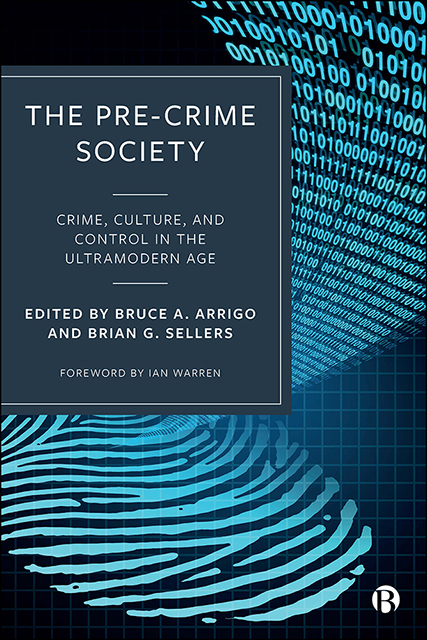Book contents
- Frontmatter
- Dedication
- Contents
- Notes on Contributors
- Foreword
- Introduction: The Ultramodern Age of Criminology, Control Societies and ‘Dividual’ Justice Policy
- Part I Theories, Theorists and Theoretical Perspectives
- Part II Institutions, Organizations and the Surveillance Industrial Complex
- Part III Dataveillance, Governance and Policing Control Societies
- Part IV Systems of Surveillance, Discipline and the New Penology
- Part V Globalizing Surveillance, Human Rights and (In)Security
- Afterword: ‘Pre-Crime’ Technologies and the Myth of Race Neutrality
- Index
3 - Pre-Crime and the ‘Control Society’: Mass Preventive Justice and the Jurisprudence of Safety
Published online by Cambridge University Press: 14 April 2023
- Frontmatter
- Dedication
- Contents
- Notes on Contributors
- Foreword
- Introduction: The Ultramodern Age of Criminology, Control Societies and ‘Dividual’ Justice Policy
- Part I Theories, Theorists and Theoretical Perspectives
- Part II Institutions, Organizations and the Surveillance Industrial Complex
- Part III Dataveillance, Governance and Policing Control Societies
- Part IV Systems of Surveillance, Discipline and the New Penology
- Part V Globalizing Surveillance, Human Rights and (In)Security
- Afterword: ‘Pre-Crime’ Technologies and the Myth of Race Neutrality
- Index
Summary
Control techniques are used not so much to identify a particular individual, but rather to identify a future risk, and to attach this risk to certain kinds of individuals … whereas disciplinary societies constituted the subject as a fixed identity—defining him according to rigid categories such as normal/abnormal, sane/mad—societies of control seek to define the individual through a series of different, modulated, and overlapping states of risk, with indeterminate and shifting borders. (Newman, 2009, pp. 106–7)
Risk and dangerousness: pre-crimes and preventive crimes
Robert Castel (1991) famously differentiated between dangerousness and risk, distinguishing between them in terms of dangerousness as a diagnosis based on the analysis of individual symptoms, and risk as involving assignment of a case to a statistical category. Individuals are dangerous to the extent that as unique subjects they are manifesting specified symptoms (of sickness, of deviance etc.) that transgress particular thresholds of severity. Castel understood dangerousness as a personal proclivity revealed through symptomology but in itself concealed: hence, dangerousness is always open to second opinions and each case is unique. Moreover, it might be considered as an indeterminable and unstable entity, changing in intensity depending on the various circumstances in which the subject is contextually situated. As such, dangerousness is associated with various long-established forms of preventive detention. However, these relate to the specific subject: to the specific individual known through complex diagnostic records and/or through the rich description of a case.
Risk, on the other hand, is not a property of the individual. Castel argues that ‘the new strategies dissolve the notion of a subject or concrete individual and put in its place a combinatory of factors, the factors of risk.’ (Castel, 1991, p. 281). The need to identify specific individuals however does not disappear in risk. Specific individuals remain available to medicine, psychiatry, criminal justice and so on, and remain their ‘targets’. However, they are known differently: through their belonging in risk pools. Little more need be known about them other than what is required to be known for this mode of risk identification and classification. Gone is the complex case history, the biography, the in-depth knowledge of the subject, the individualized intervention. Henceforward they are to be known through their risk profile—which may be as little as a score on a risk schedule or register.
- Type
- Chapter
- Information
- The Pre-Crime SocietyCrime, Culture and Control in the Ultramodern Age, pp. 63 - 80Publisher: Bristol University PressPrint publication year: 2021

